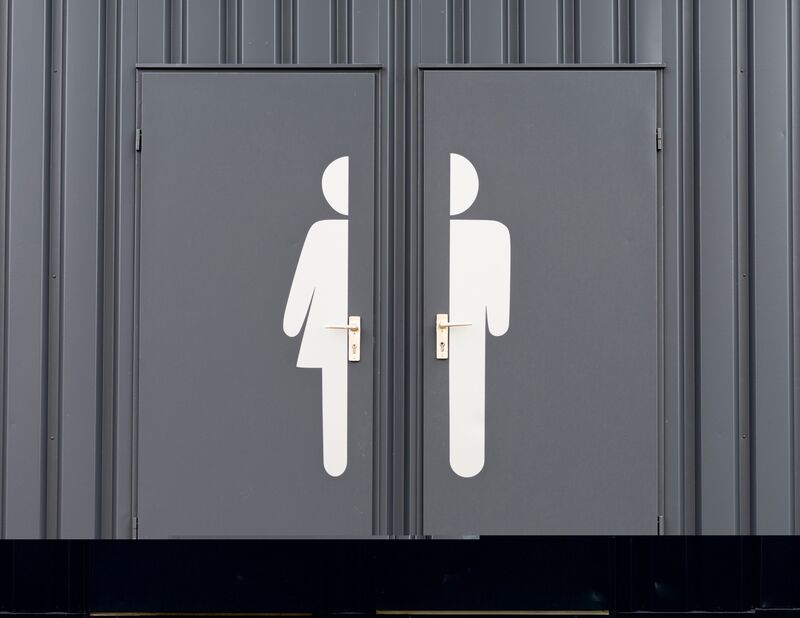
One of the pillars of Title II of the ADA is access to state and local government programs and in Title III it’s readily achievable barrier removal for people with disabilities. Essentially, barriers to access should be reasonably removed. While not all access barriers are easily removed, many fall under the “free” and “easy” categories regarding the effort needed to remove the barrier. Today I will talk about some of the most frequent and easy to remove barriers that you can find almost anywhere.
Architects are an educated population and tend to be good at including clearances that the ADA Standards require. These clearances at doors, toilets, and drinking fountains (as well as other places) are what make access possible for many people with disabilities. For example, the clearance around an accessible toilet is what allows a wheelchair user to maneuver their mobility devices so they can transfer to the toilet. Another example is at a doorway, the maneuvering clearance allows the user the space to maneuver and apply leverage to the door while using mobility devices such as wheelchairs, canes, or crutches. The US Access Board has a wonderful animation which demonstrates how clearances are used so we can understand why clearances are important to people with disabilities. What often goes wrong with these clearances is the fact that they are not maintained.
Both Titles II and III of the ADA require that accessible features be maintained, which include maneuvering and fixture clearances. The most frequent offender is the ubiquitous trashcan, placed neatly next to the doorframe. One reason waste receptacles are placed by the door is because it is an efficiency that janitorial staff use to make one of their duties a little easier. While I understand the desire to increase efficiency of a common job duty, doing so at the expense of another person’s civil rights is an unbalanced approach to this particular circumstance. Maintenance staff, especially those of Title II covered entities, should be trained to preserve these clearances as part of their responsibility to comply with all applicable state and federal laws of the covered entity.
Of course, the root of the issue I just outlined is that it wasn’t done with malicious intent, but lack of consideration. Other circumstances where these clearances are not maintained are where those clearances are used as storage. I’ve seen hallways leading to restrooms used as general storage and accessible toilet stalls used to store cleaning supplies. This happens frequently at Title III entities, such as small businesses, bars, and restaurants. The owners of these places see that clear space as valuable real estate. They want to put it to use without realizing the purpose is to be kept clear so that people with disabilities may have equitable opportunities. These opportunities aren’t people with disabilities seeking special treatment. They want to use the restroom. People having a night out with friends don’t want to leave early just because the route to the toilet is blocked by a soda machine. They do not want to mess themselves because they can’t get to the toilet. That space might be tempting, but is it worth putting a human being through that? Is it worth the potential lawsuit for disability discrimination?
I mentioned architects being pretty good at including clearances earlier, but a good architect can offer a design that helps the property owner maintain compliance with the ADA. Where I see most designs go wrong is where they see the minimum requirements of the ADA as the design requirements. What I mean is where they see a 60-inch minimum clearance from the sidewall for an accessible toilet, they design a 60” clearance. “60-inch minimum” means “this clearance needs to be at least 60 inches wide” or “do not design less than 60-inches.” “60-inch clearance” does not mean “design this at 60-inches for every circumstance” which is often the case. A good architect will consider the essential furniture or necessities of a space and include those considerations in the design. What restroom does not offer trashcans? If space for a trashcan is not anticipated by the designer, what options are left while maintaining ADA clearances?
The ADA requires that clearances should be maintained so that people with disabilities don’t need to do so much extra just to receive basic benefits that we take for granted, like indoor plumbing. The majority of the time these clearances are obstructed with movable objects. If an object can be easily moved into a clearance, it can easily be removed from the clearance and at no cost.
As the 35th anniversary of the ADA approaches this summer, I can’t think of a better way to celebrate the ADA than by furthering its implementation by practical, easy, and free methods of barrier removal. Want to learn more about clearances? Your regional ADA Center is a great resource for help.